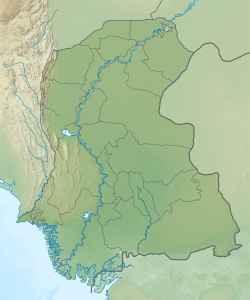| Alternative name | Agham, Aghamani, Aghamano |
|---|---|
| Location | Deh Aghamano, Matli Taluka, Badin District, Sindh, Pakistan[1] |
| Coordinates | 25°13′50″N 68°46′20″E / 25.23056°N 68.77222°E[1] |
| Type | Settlement |
| History | |
| Founded | 700s or earlier |
| Abandoned | Late 1700s |
| Site notes | |
| Condition | In ruins |
| Management | None |
Agham Kot (Sindhi: اگھم ڪوٽ), historically known as Agham and today also called Aghamani or Aghamano,[2] is a historical city and present-day ruin site located in Badin District, Sindh, Pakistan.[3][4][5][6] It is located about 1.5 km northwest of the current town of Ghulab Khan Laghari, near the border with Hyderabad District.[1] Said to be named after its 7th-century founder, the Lohana king Agham Lohana,[7] Agham Kot historically lay on the right bank of the Dhoro, a branch of the Indus River that is now dried up.[1] Because of this strategic location on an important waterway, Agham Kot was an important commercial centre in its heyday.[8]
Today, the site of Agham Kot consists of several mounds that rise 3-5 m above the surrounding farmland and are spread across an area of 200 acres.[1] Some of these mounds are crowned with old mosques or tombs, which are all in poor condition.[1] Some tombs belong to Sufi saints and draw pilgrims from throughout Sindh.[4] Only a small portion of the city's old fort is still standing.[3]
- ^ a b c d e f Laghari, Muhammad Hanif; Veesar, G. Mohiuddin (2000). "History and Archaeology of Aghamano Site". Ancient Sindh. 6 (6): 75–85. Retrieved 6 January 2022.
- ^ Akhtar, Muhammad Saleem (1983). Shāhjahānī of Yūsuf Mīrak (1044/1634) Sind under the Mughuls: an introduction to, translation of and commentary on the Maẓhar-i Shāhjahānī of Yūsuf Mīrak (1044/1634). pp. 106–7. doi:10.25911/5d74e2bda15ab. hdl:1885/11279. Retrieved 6 January 2022.
- ^ a b "The Agham Kot dilemma - is Sindh's apathy erasing its history?". The Express Tribune. 15 March 2019. Retrieved 4 September 2020.
- ^ a b "Splendour of Agham Kot". The Friday Times. 8 February 2019. Retrieved 4 September 2020.
- ^ The Archeology: An Organ of the Friends of Cultural and Archeeological [i.e. Archaeological] Heritage of Pakistan. International Press & Publications Bureau. 1989.
- ^ Elliot, Sir Henry Miers (1867). The History of India, as Told by Its Own Historians: The Muhammadan Period. Trübner.
- ^ Elliot, Henry Miers (21 March 2013). The History of India, as Told by Its Own Historians: The Muhammadan Period. Cambridge University Press. p. 362. ISBN 9781108055833.
- ^ Dars, Muhammad Sultan (2018). "Agham Kot — a forgotten archaeological site of Sindh". Daily Times. Retrieved 9 January 2022.

